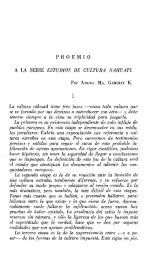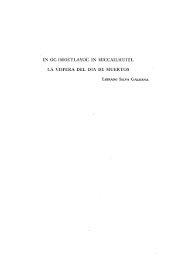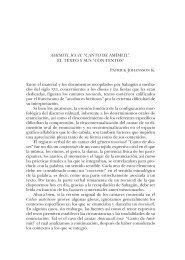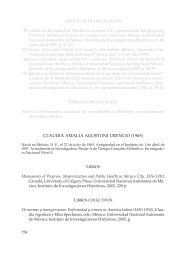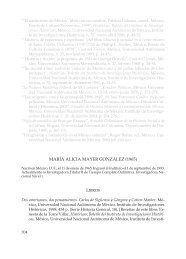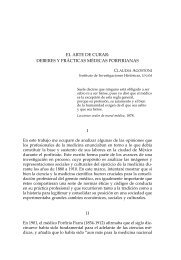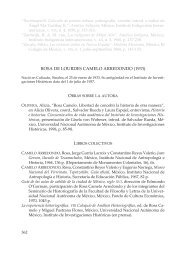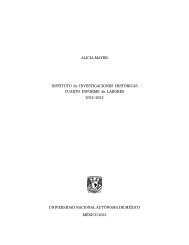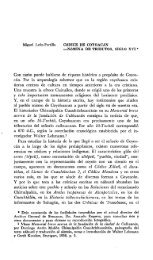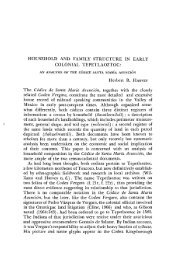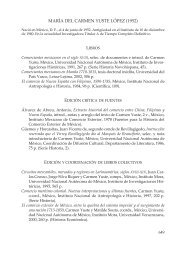“HOLY FAMILY”. THE NAHUATL KINSHIP TERMS IN THE ...
“HOLY FAMILY”. THE NAHUATL KINSHIP TERMS IN THE ...
“HOLY FAMILY”. THE NAHUATL KINSHIP TERMS IN THE ...
Create successful ePaper yourself
Turn your PDF publications into a flip-book with our unique Google optimized e-Paper software.
The Nahuatl kinship terms in the context of Christianity 121<br />
çomahuiznantzin is attested only in testaments, probably because of<br />
personal character of this kind of sources. One comes upon it already<br />
in the initial part of will and it is worth mentioning that the context<br />
in which this form is attested does not find its equivalent in Alonso<br />
de Molina’s model testament that was broadly used by notaries in<br />
colonial Mexico (1569: ff. 61r-63v). This context is a prayer for St.<br />
Mary’s intercession with Jesus Christ on behalf of the testator, e.g.:<br />
...notlasomahuiznatzin sata Maria mochipa huel neli yxpochtli ynic nopapan<br />
quimotlatlatiliatzinnos yn itlasomahuizseteConnetzin yn t to x to 35 (Lockhart,<br />
1991: 138). That the Nahuas particularly stressed the role of St. Mary<br />
as an interecessor is additionally suggested in one of the sources, by<br />
inserting this concept into the complex term notepantlatocanantzin (my<br />
intercessor and mother) (Beyond… 1976: 112). In other document the<br />
two elements of this designation have been separated: notepantlatocatzin<br />
ytlazohnantzin ciuapilli Sancta Maria 36 (Beyond… 1976: 44).<br />
Far more problematic is the usage of the grammatical form<br />
notlaço(mahuiz)nantzin with reference to churches and cofradías having St.<br />
Mary and other female saints as patron saints, as well as to the images<br />
of female saints. The difficulties emerge when the contexts in which the<br />
term –nan is attested are to be classified and they result from the aforementioned<br />
usual ignorance of the specific category to which the proper<br />
name belongs. Special thanks should go here to the authors of Beyond<br />
the Codices, who successfully traced a lot of units hidden beneath otherwise<br />
obscure proper names (see: ibid.: 70, n. 2). In cases where they<br />
managed to establish what the grammatical form notlaço(mahuiz)nantzin<br />
referred to, it almost always was a cofradía, e.g.: nicnomaquilitiuh ynotlazomahuiznantzin<br />
candelaria 37 (ibid.: 70). In this and other similar examples,<br />
by “my mother” the writer most probably meant the patron<br />
saint of the cofradía to which he belonged, hence the term —nan would<br />
connote here a relationship between pupil and patron.<br />
Choosing the term nonan- with reference to the image of St. Mary<br />
could have placed her within the group of the household saints (see:<br />
“Father as owner”). Since all the examples analyzed here come from<br />
wills, St. Mary ordinarily appears in them, apart from the preamble,<br />
as a part of inheritance (thus most likely a picture or figure) or as a<br />
heir (an image, but also a cofradía, church, etc). In one of the sources<br />
the patron saint of a local church, St. Catherine, was treated similarly,<br />
receiving a granddaughter (!) of a testator along with a piece of land.<br />
35<br />
“my precious honored mother St. Mary, forever a very true virgin, [I desire] that on<br />
my behalf she implore her precious honored one child, our lord Jesus Christ”.<br />
36<br />
“My intercessor his precious mother [of Jesus] lady Saint Mary”.<br />
37<br />
“I am giving him to (the cofradia of) my dear honored mother (of) Candelaria”.





